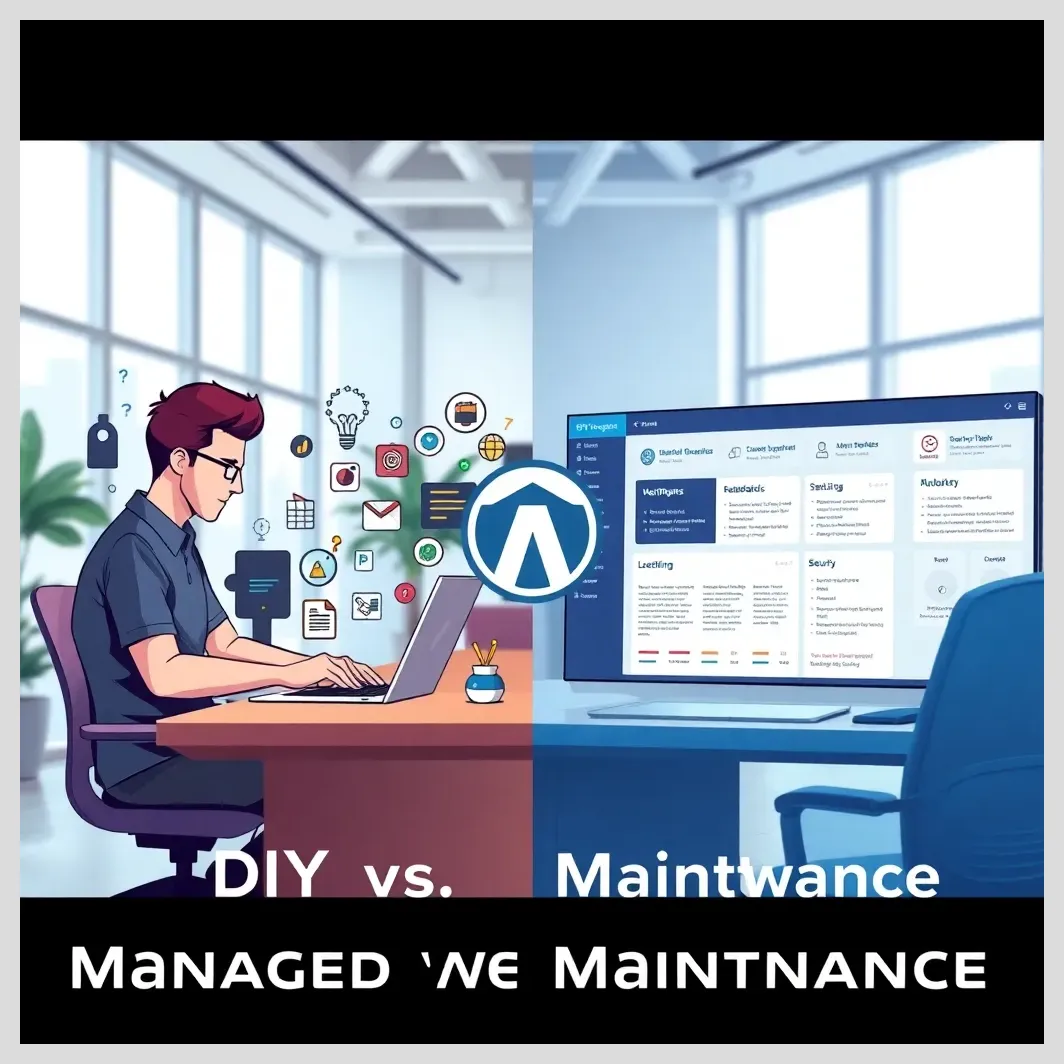In this article:
Unlocking Fast, Reliable, and Secure WordPress Sites in 2025
In this comprehensive guide, we will explore the essential aspects of website upkeep and how to accelerate your WordPress site in 2025. From choosing the right hosting provider to manual optimization techniques and leveraging caching plugins, you’ll learn how to keep your website fast, secure, and user-friendly. We’ll also introduce Modular DS, a powerful solution for agencies and professionals to automate and centralize WordPress site management, helping you maintain peak performance effortlessly.
Key points covered in this article include
- Understanding the role of website maintenance in speed optimization
- How WordPress site speed impacts user experience and SEO
- Choosing the best hosting for speed and reliability
- Essential maintenance practices like backups, updates, and database optimization
- Manual speed-up techniques without relying on plugins
- Using caching plugins and CDNs effectively
- Mobile optimization strategies for 2025
- Advanced autoloaded data management and database tuning
- Comparing Modular DS with other WordPress management tools
- Common pitfalls and expert insights
- A practical checklist to keep your site fast and secure

Speed up wordpress site 2025
Website Maintenance and Its Role in Speed Optimization
Website maintenance is the ongoing process of keeping your WordPress site updated, secure, and performing at its best. It involves tasks like updating WordPress core, themes, and plugins, backing up data, optimizing databases, and monitoring performance. Regular maintenance is crucial because it prevents issues that can slow down your site or cause security vulnerabilities.
When you maintain your website properly, you reduce the chances of outdated code, plugin conflicts, and database bloat—all common culprits behind slow WordPress performance. Maintenance also ensures your site stays compatible with the latest web standards and hosting environments, which directly affects speed and user experience.
Common maintenance tasks that impact speed include
- Updating WordPress core, themes, and plugins to their latest versions
- Removing unused or outdated plugins and themes
- Cleaning up the database by deleting spam comments, post revisions, and expired transients
- Backing up your site regularly to avoid data loss during troubleshooting
- Monitoring site speed and performance metrics to catch issues early
By integrating these upkeep routines into your workflow, you ensure your WordPress site remains fast, reliable, and secure over time.
How WordPress Site Speed Affects User Experience and SEO in 2025
Speed is no longer just a nice-to-have; it’s a critical factor for user experience and SEO in 2025. Google’s Core Web Vitals—Largest Contentful Paint (LCP), Interaction to Next Paint (INP), and Cumulative Layout Shift (CLS)—measure how fast your site loads, how responsive it is, and how stable the layout appears during loading. These metrics influence your search rankings and how visitors perceive your site.
A fast WordPress site keeps visitors engaged, reduces bounce rates, and increases conversions. Slow-loading pages frustrate users, causing them to leave before your content even appears. This hurts your SEO because search engines prioritize sites that offer smooth, speedy experiences.
Mobile-first indexing means Google predominantly uses the mobile version of your site for ranking. If your mobile site is sluggish, your overall SEO suffers. Optimizing for mobile speed is essential to meet user expectations and maintain visibility in search results.
Real-world examples show that even a one-second delay in page load can reduce conversions by up to 7%. That’s why focusing on speed optimization is a smart business move.
Choosing the Right Hosting for a Fast WordPress Site in 2025
Your hosting provider is the foundation of your WordPress site’s speed and reliability. A slow or unreliable host can negate all your optimization efforts. In 2025, look for hosting that offers SSD or NVMe storage, fast server response times, PHP 8.x support, and built-in CDN integration.
Hosting types vary
- Shared Hosting Affordable but often slow due to resource sharing.
- VPS Hosting More control and resources, better performance.
- Managed WordPress Hosting Optimized specifically for WordPress with expert support.
- Cloud Hosting Scalable, fast, and reliable with global data centers.
Top providers include WPX Hosting, Rapyd Cloud, and Elementor Hosting, each offering unique advantages.
Introducing Modular DS , a centralized WordPress site management and hosting solution designed for agencies and professionals. Modular DS automates updates, backups, performance monitoring, and security across multiple sites from one dashboard, saving time and reducing errors.
| Feature | Modular DS | Traditional Hosting + Manual Management |
|---|---|---|
| Centralized Dashboard | ✔️ | ❌ |
| Automated Updates & Backups | ✔️ | Manual |
| Performance Monitoring | ✔️ | Limited |
| Security Features | Built-in | Depends on host/plugins |
| Pricing (Approx.) | Starts at $29/mo | Varies widely |
Pros of Modular DS Streamlines site management, reduces manual work, improves site speed through automated maintenance, excellent for agencies managing multiple sites.
Cons Monthly cost may be higher than basic hosting, requires some learning curve to use the dashboard effectively.
Advantages and Disadvantages
Advantages
Improves site speed and reliability through regular maintenance and optimization.
Enhances user experience and SEO rankings by meeting Core Web Vitals standards.
Centralized management with Modular DS automates updates, backups, and monitoring for agencies.
Manual optimization techniques reduce dependency on plugins and improve performance.
Mobile optimization strategies ensure fast loading and better rankings on mobile devices.
Use of caching plugins and CDNs significantly reduces server load and speeds up content delivery.
Disadvantages
Modular DS has a monthly subscription cost that may be higher than basic hosting options.
There is a learning curve to effectively use the Modular DS dashboard and features.
Over-reliance on plugins without addressing hosting or database issues can limit speed improvements.
Neglecting mobile optimization or regular maintenance can hurt SEO and user experience.
Manual optimization requires technical knowledge and effort, which may be challenging for some users.
Essential Website Maintenance Practices to Boost WordPress Speed
Regular upkeep is key to maintaining a fast WordPress site. Start with consistent backups to protect your data. Use reliable backup plugins or your host’s backup service to schedule daily or weekly backups.
 Optimizing WordPress for Google Core Web Vitals Using ModularDS
Optimizing WordPress for Google Core Web Vitals Using ModularDSKeep WordPress core, themes, and plugins updated to patch security holes and improve performance. Outdated software can slow your site and expose it to attacks.
Choose lightweight plugins and themes. Bloated plugins add unnecessary scripts and styles that increase load times. Audit your plugins regularly and remove those you don’t need.
Database optimization is often overlooked but vital. Clean out spam comments, post revisions, and expired transients. Use tools like phpMyAdmin or WP-Optimize to remove bloat and optimize tables.
Security maintenance protects your site from malware that can degrade performance. Use security plugins, strong passwords, and monitor for suspicious activity.
Monitor your site’s speed and health with tools like Google PageSpeed Insights and Query Monitor. These help identify bottlenecks and track improvements over time.
Manual Techniques to Speed Up WordPress Site Without Relying on Plugins
Not everyone wants to rely on plugins for speed optimization. Manual techniques can be just as effective when done right.
Image optimization is crucial. Compress images before uploading using tools like TinyPNG or ImageOptim. Resize images to the exact dimensions needed and use next-gen formats like WebP for smaller file sizes.
Enable browser caching and gzip compression by editing your site’s .htaccess file. This reduces load times by storing static files locally on visitors’ browsers. Here’s a simple snippet for caching and compression
# Enable gzip compression
AddOutputFilterByType DEFLATE text/html text/plain text/xml text/css application/javascript application/json
# Leverage browser caching
ExpiresActive On
ExpiresByType image/jpg "access plus 1 year"
ExpiresByType image/jpeg "access plus 1 year"
ExpiresByType image/gif "access plus 1 year"
ExpiresByType image/png "access plus 1 year"
ExpiresByType text/css "access plus 1 month"
ExpiresByType application/javascript "access plus 1 month"
Minify and combine CSS, JavaScript, and HTML files manually using online tools like CSS Minifier and JSCompress. This reduces file size and HTTP requests.
Limit external scripts and fonts by hosting custom fonts locally and using system fonts where possible. Each external request adds latency.
Implement lazy loading for images and videos to defer loading offscreen content until needed. WordPress supports native lazy loading with the loading=”lazy” attribute.
Update your PHP version to the latest stable release (PHP 8.x) via your hosting control panel. Newer PHP versions offer significant speed and security improvements.
Leveraging WordPress Caching Plugins and CDN for Maximum Speed
Caching is a cornerstone of WordPress speed optimization. It stores copies of your pages and serves them quickly to visitors, reducing server load.
Types of caching include
- Page caching Saves full HTML pages.
- Browser caching Stores static files in visitors’ browsers.
- Object caching Caches database queries.
- Server-level caching Provided by hosts for faster processing.
Top caching plugins for 2025 include WP Rocket (user-friendly, all-in-one), LiteSpeed Cache (best if your host supports LiteSpeed), W3 Total Cache (feature-rich), and Perfmatters (script management).
Configure caching plugins carefully to avoid conflicts and maximize benefits. Enable page caching, browser caching, and minification features.
Using a Content Delivery Network (CDN) distributes your static content globally, speeding up delivery to visitors no matter their location. Popular CDNs include Cloudflare, BunnyCDN, and WPX’s custom CDN.
Integrate your CDN with WordPress by updating DNS settings and configuring your caching plugin to rewrite URLs for static assets.
Unlocking Fast, Reliable, and Secure WordPress Sites in 2025: Practical Tips
1. Website Maintenance Essentials
- Keep WordPress core, themes, and plugins updated regularly
- Remove unused or outdated plugins and themes to reduce bloat
- Clean your database by deleting spam comments, post revisions, and expired transients
- Schedule regular backups to protect your data
- Monitor site speed and performance metrics frequently
2. Manual Speed Optimization Techniques
- Compress and resize images before uploading; use WebP format
- Enable browser caching and gzip compression via .htaccess file
- Minify and combine CSS, JavaScript, and HTML files manually
- Host custom fonts locally and limit external scripts
- Use native lazy loading for images and videos (loading=’lazy’ attribute)
3. Hosting & Caching Strategies
- Choose hosting with SSD/NVMe storage, PHP 8.x support, and fast server response
- Use managed WordPress or cloud hosting for better performance and reliability
- Implement caching plugins like WP Rocket, LiteSpeed Cache, or W3 Total Cache
- Integrate a CDN (Cloudflare, BunnyCDN, WPX CDN) for global content delivery
- Configure caching and CDN settings carefully to avoid conflicts and maximize speed
4. Mobile Optimization Tips
- Use responsive, mobile-friendly themes like Astra or Divi
- Compress and resize images specifically for mobile devices
- Defer non-critical JavaScript and CSS to prevent render-blocking
- Use resource hints like preload and preconnect for important assets
- Test mobile performance with Google Mobile-Friendly Test and PageSpeed Insights
5. Advanced Database & Data Management
- Identify and clean bloated autoloaded data in the wp_options table
- Remove leftover data from unused plugins and themes
- Disable autoload for non-essential options and clean expired transients regularly
- Add database indexes for large sites to speed up queries
6. Using Modular DS for Centralized Management
- Automate updates, backups, and performance monitoring across multiple sites
- Centralize site management with a single dashboard for agencies and professionals
- Improve site speed and security through proactive automated maintenance
- Consider Modular DS for scalable, efficient WordPress site management
Mobile Optimization Strategies for WordPress Sites in 2025
Mobile traffic dominates the web, so optimizing your WordPress site for mobile is essential.
Use responsive, mobile-friendly themes like Astra or Divi that adapt layouts to different screen sizes seamlessly.
 DIY vs Managed WordPress Maintenance Plans: Which is Better for Your UK Site?
DIY vs Managed WordPress Maintenance Plans: Which is Better for Your UK Site?Optimize images specifically for mobile by compressing and resizing them to smaller dimensions. Use next-gen formats like WebP for faster loading.
Defer non-critical JavaScript and CSS to prevent render-blocking on mobile devices. This means loading essential content first and delaying scripts that aren’t immediately needed.
Use resource hints such as preload and preconnect to tell browsers to fetch important resources early.
Test your mobile performance with Google’s Mobile-Friendly Test and PageSpeed Insights to ensure your site meets Core Web Vitals thresholds (LCP under 2.5s, INP under 200ms, CLS under 0.1).
Advanced Database Optimization and Autoloaded Data Management
Autoloaded data in WordPress refers to options stored in the database that load on every page request. Excessive autoloaded data slows down database queries and site speed.
Identify bloated autoloaded data using phpMyAdmin with SQL queries or plugins like WP-Optimize. Look for entries in the wp_options table flagged as “autoload” with large sizes.
Remove leftover data from unused plugins and themes, disable autoload for non-essential options, and clean expired transients regularly.
For large sites, adding database indexes can speed up queries significantly.
Regularly audit your plugins and themes to prevent database bloat. Choose lightweight, well-coded plugins and remove those you don’t need.
Comprehensive Comparison: Modular DS vs. Other WordPress Site Management Solutions
Modular DS is a powerful platform designed to automate and centralize WordPress site management for agencies and professionals. It offers features like automated updates, backups, performance monitoring, security scanning, and multi-site management from a single dashboard.
| Feature | Modular DS | Competitor A | Competitor B |
|---|---|---|---|
| Centralized Dashboard | ✔️ | ✔️ | ❌ |
| Automated Updates & Backups | ✔️ | Partial | Manual |
| Performance Monitoring | ✔️ | Limited | No |
| Security Features | Built-in | Add-ons | Depends |
| Pricing (Approx.) | Starts at $29/mo | Varies | Varies |
Advantages of Modular DS
- Automates repetitive maintenance tasks saving time
- Centralizes management of multiple WordPress sites
- Improves site speed and security through proactive monitoring
- Offers transparent pricing and excellent support
Disadvantages
- Monthly subscription cost may be higher than DIY solutions
- Some users may need time to adapt to the platform
Real success stories from Modular DS users highlight improved site uptime, faster load times, and reduced maintenance overhead. Agencies especially benefit from the streamlined workflows and centralized control.
Explore Modular DS today for efficient, scalable WordPress site management: https://modulards.com/en/?fpr=bilbo
Comparison of WordPress Hosting & Management Solutions in 2025
Common Mistakes and Pitfalls When Speeding Up WordPress Sites
Many WordPress users try to speed up their sites but fall into common traps. One is overloading the site with too many plugins or heavy themes, which adds unnecessary scripts and slows performance.
Ignoring mobile optimization is another mistake. Since mobile-first indexing dominates SEO, neglecting mobile speed hurts rankings and user experience.
Neglecting regular maintenance like updates and backups leads to outdated software and security risks that degrade speed.
Relying solely on plugins without addressing hosting quality or database issues often yields limited improvements.
Poor image handling—uploading large, uncompressed images—and excessive HTTP requests from external scripts also drag down load times.
Avoid these pitfalls by combining good hosting, regular upkeep, manual optimizations, and selective plugin use.
 Best Practices for WordPress Brute Force Attack Prevention in 2025
Best Practices for WordPress Brute Force Attack Prevention in 2025
Speed up wordpress site 2025
Real User Opinions and Expert Insights on WordPress Speed Optimization in 2025
“Switching to a managed WordPress host and using WP Rocket cut our load times in half. The difference in user engagement was immediate.” – Sarah M., Digital Marketer
“Cleaning autoloaded data was a game-changer for our large WooCommerce site. The database queries sped up noticeably.” – James T., WordPress Developer
“Modular DS helped our agency manage 50+ client sites effortlessly. Automated updates and backups freed up hours every week.” – Lisa K., Agency Owner
Experts agree that a holistic approach combining hosting, maintenance, manual tuning, and caching plugins delivers the best WordPress speed results in 2025.
Step-by-Step Checklist for Speeding Up Your WordPress Site in 2025
- Choose high-performance hosting with SSD/NVMe and PHP 8.x support
- Regularly backup your website and update WordPress core, themes, and plugins
- Audit and remove unnecessary plugins and themes
- Optimize images before uploading (compress, resize, use WebP)
- Enable browser caching and gzip compression via .htaccess
- Minify and combine CSS, JavaScript, and HTML files
- Use lazy loading for images and videos
- Implement a caching plugin like WP Rocket or LiteSpeed Cache
- Integrate a CDN for global content delivery
- Optimize autoloaded data and clean your database regularly
- Ensure your site is mobile-optimized with responsive design and deferred scripts
- Monitor performance continuously with tools like Google PageSpeed Insights
- Consider using Modular DS for automated, centralized site management
Document your changes and measure improvements to maintain a fast, reliable, and SEO-friendly WordPress site.
Summary: How to Achieve a Fast, Reliable, and SEO-Friendly WordPress Site in 2025
Speeding up your WordPress site in 2025 requires a balanced approach. Start with solid hosting that supports the latest technologies and offers fast response times. Maintain your website regularly by updating software, backing up data, and optimizing your database.
Use manual optimization techniques like image compression, caching, and minification to reduce load times without over-relying on plugins. When plugins are needed, choose reputable caching and optimization tools carefully configured for your site.
Don’t forget mobile optimization—it’s essential for user experience and SEO. Manage autoloaded data and database bloat to keep backend performance sharp.
For agencies and professionals managing multiple WordPress sites, Modular DS offers a compelling solution to automate and centralize maintenance, boosting efficiency and site speed.
Combining these strategies will help you build a fast, reliable, secure, and SEO-friendly WordPress website that stands out in 2025.
References and Further Reading
- How To Fix A Slow WordPress Website? 2025 Guide – Elementor
- Top 10 Best WordPress Speed Optimization Plugins in 2025 – Rapyd Cloud
- How to Optimize WordPress On Mobile In 2025 – NitroPack
- Speed Up Your WordPress Site by Optimizing Autoloaded Data – Pressable
- 11 Powerful Ways To Increase WordPress Speed Without Plugins – WPX Hosting
- How Will You Configure Your WordPress Development Setup in 2025? – LateNode
- Best WordPress Speed Plugins for 2025 – UXify
- How Can I Optimize the Performance of a WordPress Website? – DigitalOcean
Frequently Asked Questions About Speeding Up WordPress Sites in 2025
What is the easiest way to speed up my WordPress site without plugins?
Start by choosing a fast hosting provider, optimize your images before uploading, enable browser caching and gzip compression via your .htaccess file, and update to the latest PHP version. These manual steps can significantly improve speed without plugins.
How often should I perform website maintenance to keep my site fast?
Perform basic maintenance like backups and updates weekly or biweekly. Database optimization and audits can be done monthly. Regular monitoring helps catch issues early.
Can hosting really affect WordPress speed that much?
Absolutely. Hosting impacts server response times, resource availability, and overall reliability. A good host with SSD/NVMe storage and PHP 8.x support can drastically improve your site’s speed.
What are autoloaded data and how do they impact performance?
Autoloaded data are options in your WordPress database loaded on every page request. Excessive or bloated autoloaded data slow down database queries, reducing site speed.
Is Modular DS suitable for small businesses or only agencies?
While Modular DS is designed with agencies in mind, small businesses managing multiple WordPress sites can also benefit from its automation and centralized management features.
How do I test if my WordPress site is optimized for mobile?
Use Google’s Mobile-Friendly Test and PageSpeed Insights tools. They analyze your site’s mobile usability and Core Web Vitals, providing actionable recommendations.
What caching plugin is best for beginners in 2025?
WP Rocket is often recommended for beginners due to its user-friendly interface and all-in-one optimization features.
How can I safely update PHP without breaking my site?
Check plugin and theme compatibility first, back up your site, then update PHP via your hosting control panel. Test your site thoroughly after the update.
If you have questions, opinions, or want to share your experience about speeding up WordPress sites in 2025, please leave a comment below! For example, what do you think about using Modular DS? How do you handle autoloaded data? What’s your favorite caching plugin? Your input helps everyone learn and improve.

















